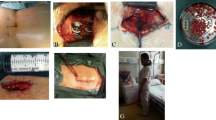Abstract
Lumbar spinal fusion is advancing with minimally invasive techniques, bone graft alternatives, and new implants. This has resulted in significant reductions of operative time, duration of hospitalization, and higher success in fusion rates. However, costs have increased as many new technologies are expensive. This study was carried out to investigate the clinical outcomes and fusion rates of a low implant load construct of unilateral pedicle screws and a translaminar screw in transforaminal lumbar interbody fusion (TLIF) which reduced the cost of the posterior implants by almost 50%. Nineteen consecutive patients who underwent single level TLIF with this construct were included in the study. Sixteen patients had a TLIF allograft interbody spacer placed, while in three a polyetheretherketone (PEEK) cage was used. Follow-up ranged from 15 to 54 months with a mean of 32 months. A clinical and radiographic evaluation was carried out preoperatively and at multiple time points following surgery. An overall improvement in Oswestry scores and visual analogue scales for leg and back pain (VAS) was observed. Three patients underwent revision surgery due to recurrence of back pain. All patients showed radiographic evidence of fusion from 9 to 26 months (mean 19) following surgery. This study suggests that unilateral pedicle screws and a contralateral translaminar screw are a cheaper and viable option for single level lumbar fusion.



Similar content being viewed by others
References
Aebi M, Steffen T (2000) Synframe: a preliminary report. Eur spine J 9(suppl 1): S44–S50 1
Ames CP, Acosta FL Jr, Chi J, Iyengar J, Muiru W, Acaroglu E, Puttlitz CM (2005) Biomechanical comparison of posterior lumbar interbody fusion and transforaminal lumbar interbody fusion performed at 1 and 2 levels. Spine 30(19):E562–E566
Beaubien BP, Derincek A, Lew WD, Wood KB (2005) In vitro, biomechanical comparison of an anterior lumbar interbody fusion with an anteriorly placed, low-profile lumbar plate and posteriorly placed pedicle screws or translaminar screws. Spine 30(16):1846–1851
Beringer WF, Mobasser JP (2006) Unilateral pedicle screw instrumentation for minimally invasive transforaminal lumbar interbody fusion. Neurosurg Focus 20(3):E4
Best NM, Sasso RC (2006) Efficacy of translaminar facet screw fixation in circumferential interbody fusions as compared to pedicle screw fixation. J Spinal Disord Tech 19(2):98–103
Deguchi M, Cheng BC, Sato K, Matsuyama Y, Zdeblick TA (1998) Biomechanical evaluation of translaminar facet joint fixation. A comparative study of poly-l-lactide pins, screws, and pedicle fixation. Spine 23(12):1307–1312 discussion 1313
Fischgrund JS, Mackay M, Herkowitz HN, Brower R, Montgomery DM, Kurz LT (1997) 1997 Volvo Award winner in clinical studies. Degenerative lumbar spondylolisthesis with spinal stenosis: a prospective, randomized study comparing decompressive laminectomy and arthrodesis with and without spinal instrumentation. Spine 22(24):2807–2812
Goel VK, Lim TH, Gwon J, Chen JY, Winterbottom JM, Park JB, Weinstein JN, Ahn JY (1991) Effects of rigidity of an internal fixation device. A comprehensive biomechanical investigation. Spine 16(3 Suppl):S155–S156
Grob D, Humke T (1998) Translaminar screw fixation in the lumbar spine: technique, indications, results. Eur Spine J 7(3):178. doi:10.1007/s005860050053
Heggeness MH, Esssess SI (1991) Translaminar facet joint screw fixation for lumbar and lumbosacral fusion. A clinical and biomechanical study. Spine 16(Suppl 6):S266–S269
Jang JS, Lee SH (2005) Minimally invasive transforaminal lumbar interbody fusion with ipsilateral pedicle screw and contralateral facet screw fixation. J Neurosurg Spine 3(3):218–223
Kabins MB, Weinstein JN, Spratt KF, Found EM, Goel VK, Woody J, Sayre HA (1992) Isolated L4–L5 fusions using the variable screw placement system: unilateral versus bilateral. J Spinal Disord 5(1):39–49
Kawaguchi Y, Matsui H, Tsuji H. Back muscle injury after posterior lumbar spine surgery: (1996) A histologic and enzymatic analysis. Spine 21(8):941–944. doi:10.1097/00007632-199604150-00007
King D (1948) Internal fixation of lumbosacral fusion. J Bone Joint Surg Am 30:560–565
Magerl FP (1984) Stabilization of the lower thoracic and lumbar spine with external skeletal fixation. Clin Orthop Relat Res 189:125–41
Sasso RC, Best NM, Mummaneni PV, Reilly TM, Hussain SM (2005) Analysis of operative complications in a series of 471 anterior lumbar interbody fusion procedures. Spine 30(6):670–674
Sasso RC, Kenneth Burkus J, LeHuec JC (2003) Retrograde ejaculation after anterior lumbar interbody fusion: transperitoneal versus retroperitoneal exposure. Spine 28(10):1023–1026
Slucky AV, Brodke DS, Bachus KN, Droge JA, Braun JT (2006) Less invasive posterior fixation method following transforaminal lumbar interbody fusion: a biomechanical analysis. Spine J 6(1):78–85. doi:10.1016/j.spinee.2005.08.003
Suk KS, Lee HM, Kim NH, Ha JW (2000) Unilateral versus bilateral pedicle screw fixation in lumbar spinal fusion. Spine 25(14):1843–1847
Tuli J, Tuli S, Eichler ME, Woodard EJ (2007) A comparison of long-term outcomes of translaminar facet screw fixation and pedicle screw fixation: a prospective study. J Neurosurg Spine 7(3):287–292. doi:10.3171/SPI-07/09/287
Wang JM, Kim DJ, Yun YH (1996) Posterior pedicular screw instrumentation and anterior interbody fusion in adult lumbar spondylolysis or grade I spondylolisthesis with segmental instability. J Spinal Disord 9(2):83–88
Author information
Authors and Affiliations
Corresponding author
Rights and permissions
About this article
Cite this article
Sethi, A., Lee, S. & Vaidya, R. Transforaminal lumbar interbody fusion using unilateral pedicle screws and a translaminar screw. Eur Spine J 18, 430–434 (2009). https://doi.org/10.1007/s00586-008-0825-4
Received:
Revised:
Accepted:
Published:
Issue Date:
DOI: https://doi.org/10.1007/s00586-008-0825-4




